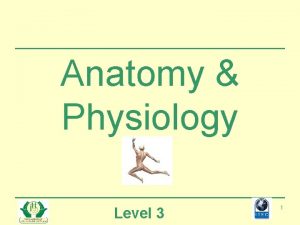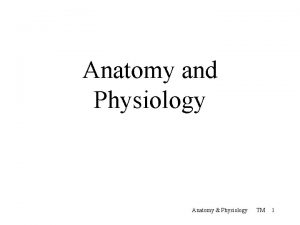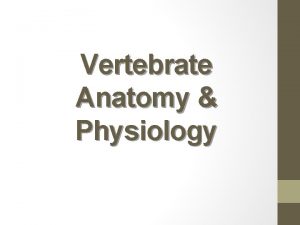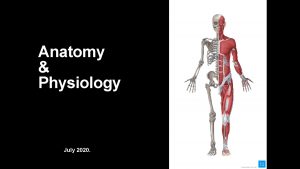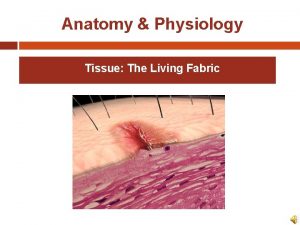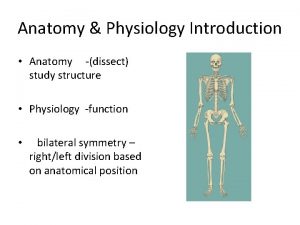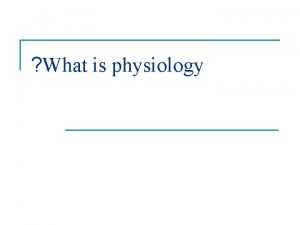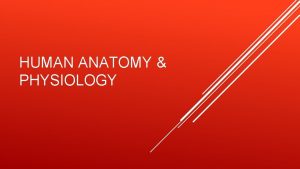Anatomy and Physiology Anatomy studies the shape and






















- Slides: 22


Anatomy and Physiology Anatomy studies the shape and structure of an organism’s body and the relationship of one body part to another. Physiology studies the function of each body part and how the functions of the various body parts coordinate to form a complete living organism.

Directions / Position Anatomical Position – body erect, arms at side, palms forward, feet shoulder width apart

Anterior or ventral -----front or in front of Posterior or dorsal ------back or in back of Cranial and caudal -----cranial = head end caudal = tail end Superior and inferior---superior: upper or above inferior: lower or below

Medial and Lateral---medial= toward the midline lateral = away from midline Proximal and Distal---proximal=toward the trunk distal = farthest from trunk Superficial or External---on or near the surface of the body Deep or Internal ---inside or about a body cavity

Planes and Sections Mid-Sagittal plane ---divides the body into right and left parts Coronal (frontal) plane --- a vertical cut at right angles to the sagittal plane, dividing the body into anterior and posterior portions (front and back) Transverse (cross section) ---a horizontal cut that divides the body into upper and lower parts.

Cavities Dorsal cavity – contains the brain and spinal cavity Cranial cavity – where the brain is located Spinal cavity – contains spinal cord Abdominal cavity –stomach, liver, gallbladder, pancreas, spleen, kidney, small intestine, appendix, and part of the large intestine. Pelvic cavity – urinary bladder, reproductive organs, rectum, remainder of the large intestine. Thoracic cavity – heart and lungs

• Oral Cavity – “mouth” including teeth and gums • Buccal Cavity – oral cavity, tongue, jaw & throat • Otic Cavity - outer, middle, & inner ear • Orbital Cavity – lacrimal duct and eyeball

Abdominal Regions • Epigastric – located just below the sternum (breast bone), and the right hypochondriac and the left hypochondriac regions are located below the ribs. • Umbilical – located around the naval or umbilicus, and the right lumbar region and the left lumbar region extend from anterior to posterior. • Hypogastric – the pubic area – right and left inguinal regions on either side.

Right Hypochondriac Epigastri c Left Hypochondriac Right Lumbar Umbilica Left Lumbar l Right Inguinal Left Inguinal Hypogast ric

Membranes MEMBRANES – formed by putting two thin layers of tissue together, cells may secrete a fluid • MUCOUS MEMBRANES– lines digestive, respiratory, reproductive and urinary systems – produces mucous to lubricate and protect the lining

SEROUS MEMBRANES – double-walled membrane - produces a watery fluid, lines closed body cavities 1. outer part of the membrane that lines the cavity is the PARIETAL membrane 2. the part that covers the organs is the VISCERAL membrane.

PLEURAL MEMBRANE – lines thoracic or chest cavity and protects the lungs PERICARDIAL MEMBRANE – lines the heart cavity and protects the heart PERITONEAL MEMBRANE – lines the abdominal cavity and protects abdominal organs

Organization of the human body: Tissues Composed of:

Types of Tissues -Epithelial tissue -Connective Tissue *adipose *cartilage *tendons *ligaments -Muscle Tissue -Nervous Tissue

Epithelial Tissue protects the body by covering internal and external surfaces, and produces secretions – Skin • covers the outside of the body • lines the inside of the body – Membrane • two thin layers of tissue that join together • cells may secrete a fluid

Connective tissue supports and connects organs and tissue – Adipose type of connective tissue that stores fat cells – Cartilage firm, flexible support of the embryonic skeleton and part of the adult skeleton – Tendons white bands of connective tissue attaching skeletal muscle to bone – Ligaments strong, flexible bands of connective tissue that hold bones to bones

Organization of the human body: Tissues Connective tissue Adipose Fibrocartilage Elastic cartilage 1. 01 Remember structural organization 18

Muscle Tissue Muscle tissue contracts and moves a body part Cardiac striated, involuntary contracts the heart Skeletal striated, voluntary attached to the skeleton Smooth • nonstriated, involuntary • provides movement in various body systems 1. 01 Remember structural organization 19

Muscle Tissue Muscle tissue Cardiac Skeletal Smooth 1. 01 Remember structural organization 20

Nervous Tissue • Nervous tissue reacts to stimulation and conducts an impulse Neuron 1. 01 Remember structural organization 21

System Functions Components Circulatory Transports cells and chemical compounds throughout the body Heart, blood vessels, blood, lymph structures Digestive Captures soluble nutrients from ingested food Mouth, esophagus, stomach, intestines, liver, pancreas Endocrine Manufactures hormones to regulate organ activity Pituitary, adrenal, thyroid, other ductless glands Immune Integumentary Removes foreign bodies from the Lymphocytes, macrophages, bloodstream; maintains homeostasis antibodies of the blood Covers and protects the body Skin, hair, nails, sweat glands Muscular Produces body movement Skeletal muscle, cardiac muscle, smooth muscle Nervous Receives stimuli, integrates information, and directs the body Nerves, sense organs, brain, spinal cord Carries out reproduction Testes, ovaries, associated reproductive structures Captures oxygen and exchanges gasses Lungs, trachea, other air passages Skeletal Protects the body and provides support for locomotion and movement Bones, cartilage, ligaments Urinary Removes metabolic wastes from the Kidney, bladder, associated ducts bloodstream Reproductive Respiratory
 Upper respiratory tract
Upper respiratory tract Tattoo anatomy and physiology
Tattoo anatomy and physiology Anatomy science olympiad
Anatomy science olympiad Incomplete flower
Incomplete flower Bone metabolism
Bone metabolism Duodenal ulcer anatomy
Duodenal ulcer anatomy Liver anatomy
Liver anatomy Difference between anatomy and physiology
Difference between anatomy and physiology Wpigastric region
Wpigastric region Anatomy and physiology of blood
Anatomy and physiology of blood The central sulcus divides which two lobes? (figure 14-13)
The central sulcus divides which two lobes? (figure 14-13) Endomysium
Endomysium Http://anatomy and physiology
Http://anatomy and physiology Chapter 1 introduction to human anatomy and physiology
Chapter 1 introduction to human anatomy and physiology Physiology of appendix
Physiology of appendix Aohs foundations of anatomy and physiology 1
Aohs foundations of anatomy and physiology 1 Aohs foundations of anatomy and physiology 1
Aohs foundations of anatomy and physiology 1 Anatomical planes
Anatomical planes Anatomy and physiology chapter 8 special senses
Anatomy and physiology chapter 8 special senses Chapter 13 anatomy and physiology of pregnancy
Chapter 13 anatomy and physiology of pregnancy Teks anatomy and physiology
Teks anatomy and physiology Science olympiad anatomy and physiology 2020 cheat sheet
Science olympiad anatomy and physiology 2020 cheat sheet Chapter 2 basic chemistry anatomy and physiology
Chapter 2 basic chemistry anatomy and physiology

































